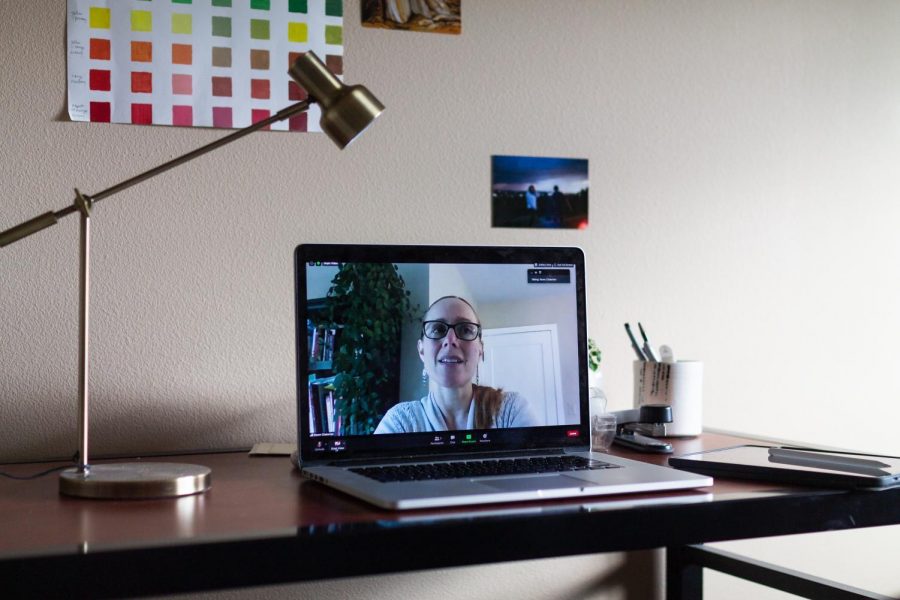Remote learning impacts teacher-student connections
November 17, 2020
When Canvas and Zoom became the new classrooms for Oregon State University students, many aspects of learning and interacting have changed, with teacher-student relationships being impacted considerably.
The pandemic and remote learning have affected connections among students and faculty, subsequently altering university experiences. With everyone having varying roles, areas of study and mindsets, the members of the OSU community are all encountering these changes differently.
Kirsi Peltomäki has been an associate professor of art history at OSU for 16 years. Though she has a specialty in contemporary art history, Peltomäki teaches a broader field, often instructing non-art majors in Baccalaureate Core classes along with art majors in smaller environments. For her, having positive relationships with students is vital to a constructive learning environment.
“We’re here to learn together, and every time I go to class, I learn something, and that’s my goal, that students learn something, too,” she said, “and that they not just learn something, but learn to consider different viewpoints and go outside of their regular thinking patterns.”
This type of engaged learning, according to Peltomäki, is only possible when positive relationships between teachers and students are happening.
With the switch to remote learning, these connections with students are some of what she misses the most about in-person teaching.
“I miss the classroom tremendously. I miss being in the same space with students. I miss having that kind of spontaneous exchange of ideas,” she said.
However, Peltomäki believes there are ways to conduct remote learning with human elements.
She said, “There are ways to build community and build that kind of connection.”
Specifically, she makes the most of synchronous learning times over Zoom, emphasizing the importance of having flowing dialogue between students and teachers, whether through actual talking or using the program’s chat function.
More generally, Peltomäki stresses the need to come from a place of compassion and clarity for her students. She also uses Canvas more for remote learning, making sure that resources are always accessible to students.
Raven Chakerian, a senior instructor I of Spanish and Italian and the spanish coordinator for 2020-2021 school year, has been an Ecampus instructor for a few years and was supposed to go back to in-person teaching last spring – however, COVID-19 had other plans.
Chakerian said that her relationships with students have generally been different as an Ecampus instructor.
“It definitely has changed the way I think about teaching,” she said.
Specifically, she attributes her different interactions with students to the online environment decentralizing her as a teacher.
“I think it was actually good for me in a lot of ways, because it didn’t put too much importance on my own role,” she explains. “When I moved to online, I think it helped me see that it wasn’t all about me.”
Despite having more experience with online teaching, Chakerian has still noticed a change in her relationships with students.
“In some ways, my online students are engaging more with the work than they were pre-pandemic.
Chakerian said that they are more responsive to her, most likely because they are spending more time on their technology as a result of remote learning.
Both Peltomäki and Chakerian stress the importance of communication between students and teachers during the pandemic. They both comment that reaching out and being proactive about questions and concerns is vital to learning and is one of the best ways to improve connections with your instructors.
Third-year biohealth sciences major Teagan James has found this advice to ring true for her – during remote learning, she has found that communicating with her instructors and using resources such as office hours have helped sustain and improve relationships.
James also highlights the importance of communication on the instructors’ side, specifically advising that they be open and honest about what’s going on and the stress we are all experiencing.
“I definitely think it’s harder to connect with them [instructors],” James said.
“I think having positive relationships helps your learning, because you’re able to reach out to your instructors if you have a better relationship – you feel more comfortable and are able to reach out and ask for help,” James explains. “I think it’s also good just for in the future to have those connections with further classes in your education if you need academic support.”
The loss of these relationships has affected her education overall; “I definitely feel like it’s both harder to learn things, and I feel like I’m learning less in my classes, just not being able to be there.”
Peltomäki, Chakerian and James all think that it’s difficult to decipher what exactly OSU can do to improve the connections between students and teachers. However, Peltomäki and James both stressed the importance of accessibility to technology and making sure the technology is reliable.
Chakerian is concerned about a specific mindset that many are continuing to hold at the university – the idea that we just need to make it through for a little longer.
“I hope that people are starting to realize that this might not go back to normal really soon, and it’s not enough to just get through,” she said
Hopefully, however, with more understanding, communication and compassion between students and teachers, relationships during remote learning can not only survive, but thrive, subsequently improving everyone’s educational experiences.
“Having a positive relationship with students and between students and instructors is sort of what creates a learning community,” Chakerian said.












































































































